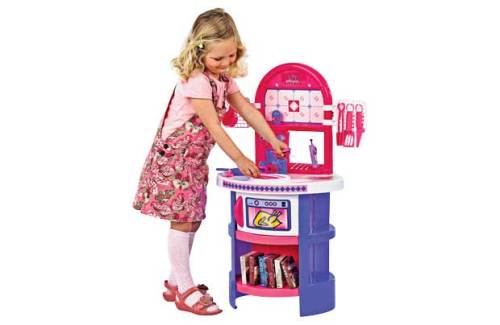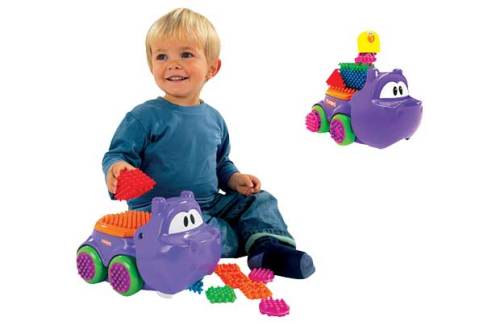I was standing outside of Gamestation browsing through their window display that contained Nintendo DS lites, Xbox and Playstation bundles, iPods and various other electrical items. A woman with her young daughter in a pram pulled up next to me and she started talking to her partner about some of the items in the display. She then noticed the Hello Kitty Nintendo DS lite and turned to her partner and said: ‘Oh look at that! A Hello Kitty one, she would love that! [looking at her daughter] You’d love a Hello Kitty one wouldn’t you?’. The child in the pram didn’t say much and just giggled when the mother spoke to her, mimiking the words ‘Hello Kitty’. I was so glad she’d said that because I needed an example to use in this blog, and that was a perfect one. I presumed the girl knew what Hello Kitty was, unless she was just repeating her mothers words, but she did get excited when the name was spoken. However, the mother did not go ‘She’d love the green one! Wouldn’t you?’ and then wait for her reaction, which i’m sure would be the same if they are a) Getting a toy b) Getting attention and c) Being smiled at.
For years the colours pink and blue have been gender specific colours, with pink being for girls and blue being for boys. However, before the 1940’s this was the other way round. With pink being a masculine colour that’s derived from red, seen as a solid colour, and blue being a feminine colour that shows ‘daintiness’ and is associated with the Virgin Mary. Due to social desirability the gender specific colours inverted, and are often displayed in children and advertisement for girls and boys. A perfect example are these images that I found on the Argos website:


On the top the girl is dressed entirely in pink standing over a plastic oven, that is also pink. This image was taken out of the ‘Role Play’ section of pre-school toys. It came as no surprise to me that girls are modelled with toys that are relevant to cooking, cleaning and caring for dolls. Interestingly, blue was not the dominant colour in boys toys and the image above was only one of a few I could find. However, boys did model toys such as tool kits, construction including work benches, power washers and toy cars, which are seen as masculine activities. The colours of these toys were usually a bright colour such as orange or yellow accompanied by black. As I was browsing other areas of the pre-school toys I came across the musical instrument section and decided to check out if they associated certain instruments with girls or boys. Instead, they produced the same the toy instruments in both blue and pink.
The ‘Beanstalk Sing Along Keyboard with Stool’ is exactly the same product in both images, except one has been produced in pink. I imagine that they both function the same, and so the most likely explanation of this marketing technique is that they don’t think the blue keyboard will attract girls, and so it’s produced in pink. If children are exposed to these kind of gender specific colours from such a young age it’s not surprising that they learn to discriminate themselves from each other. An abstract from a journal named ‘Sex Roles’ describes a study that attempted to explain the environmental gender stereotypes in the first two years of an infants life. They found that ‘The results showed that boys were provided with more sports equipment, tools, and large and small vehicles. Girls had more dolls, fictional characters, child’s furniture, and other toys for manipulation. They wore pink and multicolored clothes more often, had more pink pacifiers and jewelry. Boys wore more blue, red and white clothing. They had more blue pacifiers. Yellow bedding was more frequently observed in the girls’ rooms, while blue bedding and curtains were more prevalent in the boys’ rooms.’. To back this theory up even more, I came across a company that sells a pregnancy tester-type test for pregnant women that determines the sex of the baby before it is born. The company is called ‘pinkandblue‘, and it works by telling you if you have a girl by turning pink or a boy by turning blue.
It seems that the child is doomed to discriminate as it’s parent picks out a ‘cute pink outfit’, or decorates the room blue before it is even born. Until it’s old enough to think for itself it’s decisions have already been tainted by the choices of it’s parents, and so a girl might not beg her parent to buy a game because ‘it’s for boys’, or a man might not want to dress up his child because ‘that’s what girls do’. So how is this relevant to gaming? As I just mentioned, computers are seen as a ‘masculine’ object, and so why would a girl that has been discouraged to use one all her life decide to pick one up and play it? As you can see in the advert below, Nintendo is trying to aim their product at girls by bringing out a pink version of the DS lite:
Note that in the advert, all of the extras in focus are women except one man on the bus. The slogan used here shocked me quite a bit, to me “Great Games for Girls” would imply that someone is saying ‘these games are for girls only’. Any boy that watches this advert may no longer want to purchase them as it implies the games are not masculine. Also, girls may only buy the selection of these games, and no others. In a later advertisement Nintendo uses two members of Girls Aloud (a popular girl band with a huge female fan base) to promote the game Nintendogs. Again a pink DS lite is used, and during game play you see that she has decorated the dog with little yellow bows (at least they’re not pink, but the abstract above stated yellow was also a feminine colour) again reinforcing the gender stereotype. However, in a more recent advertisement using Girls Aloud, they are using 5 colour variations of the DS lite, with only one member holding a pink one. I much prefer this advert (and Nicole Kidman’s advert) to the previous, as it’s showing that it doesn’t matter what colour they are, they’re all having the same amount of fun.
When browsing Nintendo DS adverts I came across some games that reminded me of those that were made during the Girl Game Movement, such as McKenzie & Co. ‘My Make-up‘ is a game produced as one of a ‘My game’ series, with others including ‘My Dress-up’ and ‘My Secret Diary’. These adverts are using every pink prop possible, with pink backgrounds, accessories and clothes and again, a pink DS lite. Oh, and no boys of course. I only hope that from the bud of these girl-specific games will gender exclusive games bloom, designed for both boys and girls to enjoy on equal levels.
My main example here has been the Nintendo DS, but they’re not the only one’s to use gender specific colours in their products. Sony PlayStation released a pink version of their PlayStation 2 and PSP. Microsoft also released pink and blue controllers for their xbox 360.



Some good friends of mine – a lesbian couple – have a 9yo daughter. She loves Barbie, Bratz and anything pink and sparkly – her pink DS lite is covered in shiny stickers. No doubt her staunch preference for things to be as girly-girly as possible makes her two-mummies a bit uncomfortable, but they have always let her choose what she likes, and supported her choices.
Her main gaming partner (and best friend) is a boy. They play a lot of games together – things like MySims, mathletics, wii sports (she rocks at bowling). But they also have different preferences as well – he loves MarioKart, she likes web-based dress-up games, and they sometimes grudgingly play along with each other in those.
In her case, there has been absolutely no pressure to prefer ‘girly’ things, and her main gaming partner is a boy – the differences in preferences and the way they play fascinate me. eg she can use the wiimote well enough to trounce any adult at wii bowling, but loses interest in MarioKart, sliding off the edge, driving the wrong way etc – she clearly just isn’t engaged (I’m with her there!) despite sincerely wanting to play with her male friend.
I would love to see in-depth, detailed studies done on gender and gaming – it’s a fascinating field.